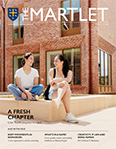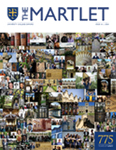Unravelling the secrets of matter
 Annika Möslein is a second year DPhil student in Engineering Science at the Multifunctional Materials & Composite (MMC) Laboratory at Oxford. Having joined the fourth year of MEng Engineering Science, she stayed in Oxford for a DPhil to pursue her two passions: science and sailing. She is an Ashton Scholar for Engineering, which is supported by the University and Old Members of University College, and has also won a Vincent’s sports scholarship. When not in the lab, she can be found talking about women in STEM, books and space exploration, or, most likely, somewhere on the sea. On the same day she passed her transfer viva, Annika joined the development team of the OxVent project to contribute her engineering skills in response to the coronavirus outbreak. See our previous news item Pioneering engineering project.
Annika Möslein is a second year DPhil student in Engineering Science at the Multifunctional Materials & Composite (MMC) Laboratory at Oxford. Having joined the fourth year of MEng Engineering Science, she stayed in Oxford for a DPhil to pursue her two passions: science and sailing. She is an Ashton Scholar for Engineering, which is supported by the University and Old Members of University College, and has also won a Vincent’s sports scholarship. When not in the lab, she can be found talking about women in STEM, books and space exploration, or, most likely, somewhere on the sea. On the same day she passed her transfer viva, Annika joined the development team of the OxVent project to contribute her engineering skills in response to the coronavirus outbreak. See our previous news item Pioneering engineering project.
 It is 3.30 am, time to change the sample. As soon as we start pumping liquid helium, everything has to work flawlessly. I pull out the five-feet long metal stick holding the radioactive sample. The Geiger counter is clicking loudly while I try to keep the radioactive material far from myself. Then, with my colleagues from the Multifunctional Materials & Composites Lab, we carefully place the new sample back into the tube of the cryostat. We quickly close the valves to create a vacuum and then – “beam on” – the neutron beam finally hits the new sample. Now, while the sample is being cooled to 10 Kelvin, (- 263 °C), we, too, can calm down as we await the emergent spectra to reveal the nature of our sample.
It is 3.30 am, time to change the sample. As soon as we start pumping liquid helium, everything has to work flawlessly. I pull out the five-feet long metal stick holding the radioactive sample. The Geiger counter is clicking loudly while I try to keep the radioactive material far from myself. Then, with my colleagues from the Multifunctional Materials & Composites Lab, we carefully place the new sample back into the tube of the cryostat. We quickly close the valves to create a vacuum and then – “beam on” – the neutron beam finally hits the new sample. Now, while the sample is being cooled to 10 Kelvin, (- 263 °C), we, too, can calm down as we await the emergent spectra to reveal the nature of our sample.
It was only my third week after commencing my DPhil in the Department of Engineering Science, and I already found myself in a week-long experiment in the accelerator-based neutron source. Since then, I have participated in and even led several beam time experiments in different particle accelerators and, still, every time I depart on one of these “missions” I feel the utter thrill of excitement coupled by the ever-present risk of failure and radiation. The challenging nature of such experiments is merged with an adrenaline boost that – with the help of yet another coffee – battles against little sleep as each hour of experiment is invaluable. In the mid-night excitement of the accelerator, we are observing phenomena that have never been explored before.
We are investigating a new class of hybrid nanomaterials called metal-organic frameworks. Since the choice of metal and organic building blocks allows a plethora of possible combinations, these multifunctional materials can be tailored to engineer desired characteristics. Additionally, the exceptional porosities of the frameworks offer the encapsulating of various guest molecules into the pores. Such host-guest systems yield unique properties – unthinkable in all other materials – which can be exploited to provide solutions for outstanding challenges in medicine, energy, communications, and the environment.
 We explore how metal-organic frameworks can be used as carriers for anti-cancer drug molecules targeted to a specific part of the body. Or, again leveraging their porosity, we tailor metal- organic frameworks to sense tiny quantities of volatile organic compounds, such as acetone. These sensing interactions lead to a visible colour change, which enables us to further tune them towards developing medical devices for non-invasive diagnosis and therapy. But why, and how, do these nanomaterials interact? And how does the underlying “catch and release” mechanism work? To answer these questions, we use accelerators and nanoscale analytics combined with quantum mechanical calculations on supercomputers, shedding light on phenomena that were invisible to us until now.
We explore how metal-organic frameworks can be used as carriers for anti-cancer drug molecules targeted to a specific part of the body. Or, again leveraging their porosity, we tailor metal- organic frameworks to sense tiny quantities of volatile organic compounds, such as acetone. These sensing interactions lead to a visible colour change, which enables us to further tune them towards developing medical devices for non-invasive diagnosis and therapy. But why, and how, do these nanomaterials interact? And how does the underlying “catch and release” mechanism work? To answer these questions, we use accelerators and nanoscale analytics combined with quantum mechanical calculations on supercomputers, shedding light on phenomena that were invisible to us until now.
Despite the strong focus on fundamental physics and chemistry, we always keep in mind engineering next-generation technical devices. I was lucky enough to be invited to present my findings to Members of Parliament at Westminster during British Science Week, bridging the gap between science and real-world solutions. I am looking forward to exploring the mysteries of nanomaterials further, and am immensely grateful for the support of the Ashton Memorial Scholarship, which has made this fascinating journey possible.
This feature was adapted from one first published in Issue 12 of The Martlet; read the full magazine here or explore our back catalogue of Martlets below:
Published: 14 January 2021

















